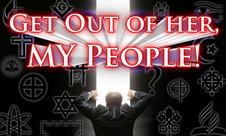Reckoning the New Year: Other Points to Consider
(2) What do 1st century historians tell us about the New Year?
Philo, a Hellenistic Jewish Philosopher who lived before, during, and after our Saviour's earthly ministry, recorded many of the details relating to Biblical calendation in the 1st century. In the below quotations, Philo confirms that the Feast of Unleavened Bread is tied to the vernal equinox and that the Feast of Ingathering is tied to the fall equinox.
"At the first season which name he gives to the springtime and its equinox, he ordained that what is called the feast of unleavened bread should be kept for seven days, all of which he declared should be honored equally in the ritual assigned to them. For he ordered ten sacrifices to be offered each day as at the new moons, whole-burnt offerings amounting to seventy in all apart from the sin offerings. He considered, that is, that the seven days of the feast bore the same relation to the equinox which falls in the seventh month as the new moon does to the month." (Philo, Special Laws I (181-182) [Colson's Translation]) [Note: Philo, here, says that the fall equinox occurs in the seventh month, just as Scripture indicates - Ex.34:22.]
To seven he gives the chief feasts prolonged for many days, two feasts, that is for the two equinoxes, each lasting seven days, the first in the spring to celebrate the ripeness of the sown crops, the second in the autumn for the ingathering of all the tree-fruits..." (Philo, The Decalogue (161) [Colson's Translation])
"...for it was the general festival of the Jews at the time of the autumnal equinox, during which it is the custom of the Jews to live in tents." (Philo, Flaccus XIV (116) [Yonge's Translation]) [Note: This quote is referring to the Feast of Ingathering, also called the "Feast of Tabernacles" or the "Feast of Booths," in which the Israelites would "dwell in booths seven days." See Lev.23:39-42.]
Flavius Josephus, a 1st century Romano-Jewish scholar, sheds even more light on the issue by confirming our understanding from another angle. Josephus comments on the position of the sun in relation to the stars at the time of the Passover.
"In the month of Xanthicus, which is by us called Nisan, and is the beginning of our year, on the fourteenth day of the lunar month, when the sun is in Aries, (for in this month it was that we were delivered from bondage under the Egyptians), the law ordained that we should every year slay that sacrifice which I before told you we killed when we came out of Egypt, and which was called the Passover..." (Flavius Josephus, Antiquities of the Jews, Book III, Chapter 10, paragraph 5, http://www.ccel.org/ccel/josephus/complete.ii.iv.x.html)
Before commenting on this intriguing quote by Josephus, it is imperative that we understand the following: The progression of the sun across the celestial equator in relation to the stars is not the same as what it was in the days of Josephus. In the 1st century, the vernal equinox would have taken place just as the sun was entering the sign of Aries (the Ram). Today, however, the equinox occurs in the sign of Pisces.
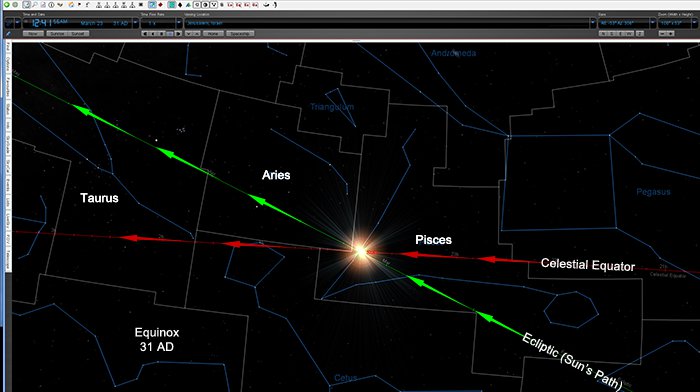
Above: Equinox, 31 AD - Note that Aries is in the immediate path of the sun following the equinox.
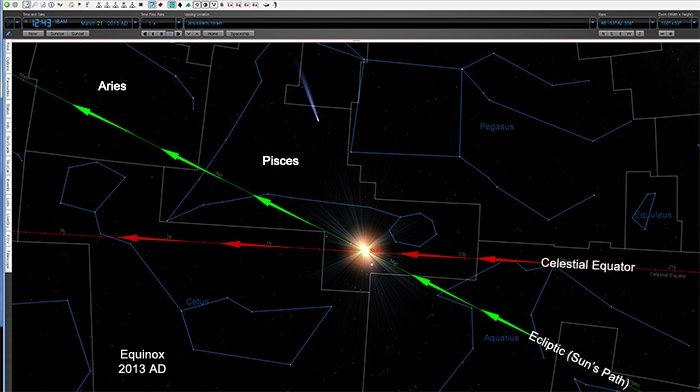
Above: Equinox, 2013 AD - Note that Aries, today, is no longer in the sun's immediate path following the equinox.
Although we cannot use the same constellation today that they did in the 1st century to determine the beginning of the year, we can determine with a fair degree of certainty how the New Year was reckoned in relation to the equinox.
Let us look again at Josephus' quote:
"In the month of Xanthicus, which is by us called Nisan, and is the beginning of our year, on the fourteenth day of the lunar month, when the sun is in Aries, (for in this month it was that we were delivered from bondage under the Egyptians), the law ordained that we should every year slay that sacrifice which I before told you we killed when we came out of Egypt, and which was called the Passover..." (Flavius Josephus, Antiquities of the Jews, Book III, Chapter 10, paragraph 5, http://www.ccel.org/ccel/josephus/complete.ii.iv.x.html)
Here, Josephus plainly states that Passover was observed when the sun was in the sign of Aries.
(2a) Is Josephus' testimony consistent with always reckoning the first New Moon after the vernal equinox as the beginning of the year?
No. If, in the 1st century, they had demanded that the first New Moon after the vernal equinox was always the beginning of the year, Passover would sometime be observed when the sun was in the sign of Taurus (well past the sign of Aries). Sometimes, this method would place Passover in Aries; sometimes it would not.
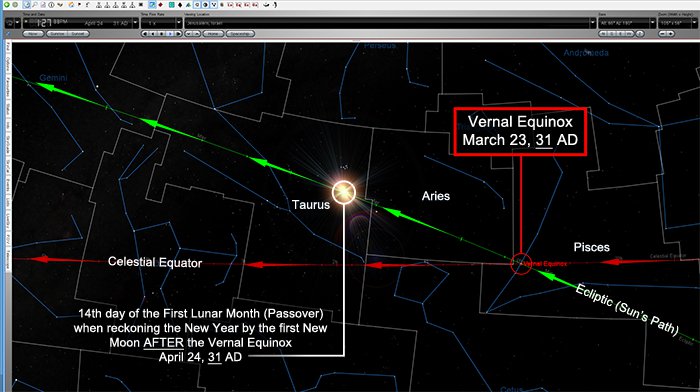
Above: 31 AD - Reckoning the first New Moon after the vernal equinox as the beginning of the year would have placed Passover (the 14th day of the lunar month) in the sign of Taurus, well beyond Aries. This does not agree with Josephus' testimony that the sun should be in Aries (1st century) on Passover. (Note: The translucent orb immediately below the sun is not the moon; it is the sun's glare, as emulated by the astronomy software.)
(2b) Is Josephus' testimony consistent with reckoning the New Moon nearest the vernal equinox as the beginning of the year?
Yes. If, in the 1st century, the New Moon nearest the vernal equinox was reckoned as the beginning of the year, Passover would have consistently fallen in close proximity to Aries. Using this method would be much more consistent with the testimony of Josephus.
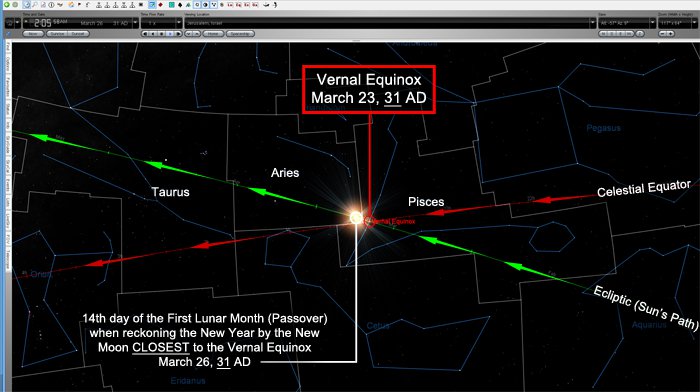
Above: 31 AD - Reckoning the New Moon nearest the vernal equinox as the beginning of the year would have placed Passover (the 14th day of the lunar month) in the sign of Aries, in agreement with Josephus' testimony.
Now let us examine a remarkable passage from Eusebius' Ecclesiastical History. Eusebius was a Roman historian who lived from about 260 AD to 340 AD. In the following passage, he is quoting from the Canons of Anatolius on the Paschal (Passover) Festival.
"And this is not an opinion of our own; but it was known to the Jews of old, even before Christ, and was carefully observed by them. This may be learned from what is said by Philo, Josephus, and Musæus; and not only by them, but also by those yet more ancient, the two Agathobuli, surnamed 'Masters,' and the famous Aristobulus, who was chosen among the seventy interpreters of the sacred and divine Hebrew Scriptures by Ptolemy Philadelphus and his father, and who also dedicated his exegetical books on the law of Moses to the same kings. These writers, explaining questions in regard to the Exodus, say that all alike should sacrifice the passover offerings after the vernal equinox, in the middle of the first month. But this occurs while the sun is passing through the first segment of the solar, or as some of them have styled it, the zodiacal circle. Aristobulus adds that it is necessary for the feast of the passover, that not only the sun should pass through the equinoctial segment, but the moon also. For as there are two equinoctial segments, the vernal and the autumnal, directly opposite each other, and as the day of the passover was appointed on the fourteenth of the month, beginning with the evening, the moon will hold a position diametrically opposite the sun, as may be seen in full moons; and the sun will be in the segment of the vernal equinox, and of necessity the moon in that of the autumnal [equinox]." (Eusebius' Ecclesiastical History, Book 7, Chapter 32, http://www.newadvent.org/fathers/250107.htm)
From this quote, we can deduce the following:
- Passover cannot fall before the equinox:
". . . all alike should sacrifice the passover offerings after the vernal equinox, in the middle of the first month."
- The full moon must occur after the equinox:
"Aristobulus adds that it is necessary for the feast of the passover, that not only the sun should pass through the equinoctial segment, but the moon also. For as there are two equinoctial segments, the vernal and the autumnal, directly opposite each other, and as the day of the passover was appointed on the fourteenth of the month, beginning with the evening, the moon will hold a position diametrically opposite the sun, as may be seen in full moons; and the sun will be in the segment of the vernal equinox, and of necessity the moon in that of the autumnal [equinox]."
At a glance, these may look like two entirely new criteria. Examining these quotations closely, though, reveals that this is actually just a more precise way of stating what we have already learned up to this point, namely that it is the New Moon closest to the vernal equinox that is to begin the year. The primary focus here should be on the full moon, which is inexorably tied to the Passover and the Feast of Unleavened Bread. The full moon is the fulcrum of the lunar month; it marks the middle of the lunar cycle. If the full moon (the middle of the lunar cycle) falls even shortly before the vernal equinox, then the next New Moon would actually be the closest to the equinox. It is not as simple as counting the number of days between each New Moon Day and the equinox, because days are not necessarily a precise indicator of the middle of the lunar cycle. That is to say that the true middle of the lunar month (i.e. the full moon) does not always coincide with the 14th day of the month; neither does it always coincide with the 15th day of the month. That said, we will sometimes be in error if we simply count the number of days between each New Moon Day and the equinox. Making sure that both Passover (the 14th day of the lunar month) and the full moon fall after the equinox is the real test. Below is an illustration of exactly what Aristobulus was referring to when he stated,
"Aristobulus adds that it is necessary for the feast of the passover, that not only the sun should pass through the equinoctial segment, but the moon also. For as there are two equinoctial segments, the vernal and the autumnal, directly opposite each other, and as the day of the passover was appointed on the fourteenth of the month, beginning with the evening, the moon will hold a position diametrically opposite the sun, as may be seen in full moons; and the sun will be in the segment of the vernal equinox, and of necessity the moon in that of the autumnal [equinox]."
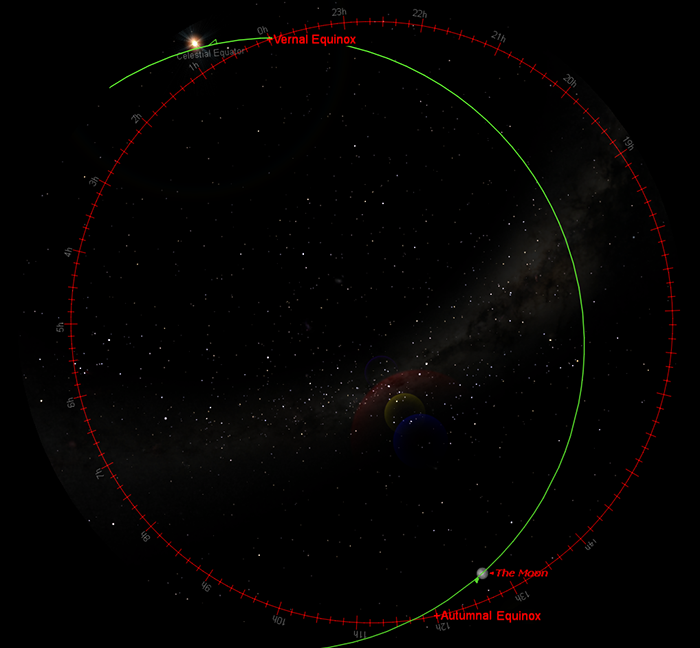
Above: This is an illustration of what happens at the first full moon after the equinox. The green circle represents the counter-clockwise path of the sun and moon. Note that both the sun and the moon have crossed the celestial equator (represented by the red line) and are positioned diametrically opposite one another at the "equinoctial points," the sun at the vernal equinox, and the moon at the autumnal equinox, exactly as described Aristobulus, according to Eusebius.
This is most remarkable! If we reckon the New Year by the New Moon closest to the vernal equinox, which rightly interpreted will place the Passover and the full moon after the equinox, we will be in harmony with the calendation details recorded by Eusebius. (It is worth noting here that Aristobulus' statement about the necessity of the vernal equinox preceding the full moon of the first month would make little sense if the New Moon after the equinox was always to begin the year. For if the New Moon after the vernal equinox always began the year, the full moon of the first month would naturally fall weeks after the equinox. The fact that Aristobulus thought it necessary to comment on this criteria suggests that the full moon of the first month would sometimes fall close to the vernal equinox.)
Note: In addition to being consistent with Eusebius' commentary on Biblical calendation principles, ensuring that Passover always falls after the vernal equinox is also very logical, in that it will guarantee that only one Passover is observed within each solar year (vernal equinox to vernal equinox).
(2c) Is the historical record in agreement with reckoning the New Year by the first New Moon after the vernal equinox?
No. Reckoning the New Year by the first New Moon after the vernal equinox:
- ...will sometimes place the Feast of Ingathering well past the fall equinox, which is not in harmony with Philo's testimony (or Scripture).
- ...will sometimes allow the fall equinox to occur in the sixth month, which is not in harmony with Philo's testimony (or Scripture).
- ...would sometimes have placed the sun in the sign of Pisces (well past the sign of Aries) at the time of the Passover in the first century, which is not in harmony with Josephus' testimony.
(2d) Is the historical record in agreement with reckoning the New Year by the New Moon closest to the vernal equinox?
Yes. Reckoning the New Year by the New Moon closest to the vernal equinox (which rightly interpreted will always place the full moon and the Passover after the equinox) is consistent with the testimony of Philo, Josephus, and Eusebius.
Conclusion:
The testimony of early historians indicates that it was the New Moon closest to the vernal equinox that began the year (which rightly interpreted will always place the full moon and the Passover after the equinox). One cannot maintain harmony with the testimonies of Philo and Josephus, while adhering to the first New Moon after the equinox methodology of reckoning the New Year.
(3) Scripture indicates that the sun, moon, and stars are to be used for timekeeping. (Gen.1:14-16)
(3a) When reckoning the New Year by the first New Moon after the vernal equinox, are all three taken into account (sun, moon, & stars)?
No. Josephus' testimony of how the stars (i.e. the sign of Aries) coincided with Passover in the first century must be disregarded in order to cling to this method of reckoning.
(3b) When reckoning the New Year by the New Moon closest to the vernal equinox, are all three taken into account (sun, moon, & stars)?
Yes. This method is in harmony with Josephus' testimony of how the stars (i.e. the sign of Aries) coincided with Passover in the first century.
Note: Although the apparent progression of the sun across the celestial equator in relation to the stars is not the same as it was in the days of Josephus, we can still use the stars in a sense to confirm the beginning of the year. While it might on a rare occasion be possible for the sun to reach the sign of Aries by Passover, the sun will most often be in the sign of Pisces on Passover. Today, the sun will always be in Pisces when the vernal equinox takes place, and in Virgo when the fall equinox takes place.
Conclusion:
Reckoning the New Year by the New Moon closest to the vernal equinox is consistent with Scripture, in that it takes into account, and is in harmony with the historical testimony of how the stars (i.e. the constellation of Aries) coincided with Passover in the first century.
(4) According to the Metonic Cycle, there are seven embolismic years within a 19-year cycle: 1 2 3 4 5 6 7 8 9 10 11 12 13 14 15 16 17 18 19
(4a) Is the Metonic Cycle manifested when reckoning the New Year by the New Moon closest to the vernal equinox?
Yes. This is proof only of our Creator's marvelous design. The establishment of the Metonic Cycle does not prove any particular method of reckoning, but is worth studying, as it shows us where we are in the grand scheme of embolismic years. (See Metonic Cycle Chart.)
(5) There were two total lunar eclipses (often called "blood moons") in 2014 and two total lunar eclipses in 2015 (4 in all; a "tetrad"). Could this very rare occurrence have been a sign pointing Yahuwah's faithful to the correct method of determining the New Year?
Given the tremendous importance that Scripture places on the heavenly bodies, it is not unreasonable to conclude that these eclipses are, in fact, a divine marker, and that their coinciding with the annual Feasts was not arbitrary.
"He appoints the number of the stars, He gives names to all of them. Great is our Master and mighty in power, There is no limit to His understanding." (Psalm 147:4-5, ISR)
"Lift up your eyes on high and see. Who has created these? He who is bringing out their host by number, He calls them all by name, by the greatness of His might and the strength of His power – not one is missing." (Isa.40:26, ISR)
(5a) Did these eclipses coincide with the first day of Unleavened Bread and the first day of Tabernacles both years when reckoning the New Year by the first New Moon after the vernal equinox?
No. They coincided only with the Feasts in 2014. The Feasts in 2015 fell one month later than the eclipses.
(5b) Did these eclipses coincide with the first day of Unleavened Bread and the first day of Tabernacles both years when reckoning the New Year by the New Moon closest to the vernal equinox?
Yes. They coincided with the Feasts in both years (2014 & 2015).
Conclusion:
It would be irresponsible for Yahuwahs' faithful to disregard the signs taking place in the heavens. It is Yahuwah's hand that upholds and orchestrates everything in the universe. Yahuwah's faithful should be especially mindful and observant of all that takes place in the heavens.
And I will shew wonders in heaven above, and signs in the earth beneath; blood, and fire, and vapour of smoke: The sun shall be turned into darkness, and the moon into blood, before that great and notable day of the Master come. (See Acts 2:19-20.)
Note: This is not necessarily intended to be evidence in favor of using the nearest New Moon to the vernal equinox method of reckoning, for there have been tetrads of lunar eclipses in the recent past (e.g. 1967-1968) that would not have lined up with the feasts using this reckoning. It is, however, very interesting to note this phenomenon.
| WLC believes, based on the Exodus 34:22 mandate, that the Biblical New Year is reckoned by the New Moon closest to the vernal equinox. The historical commentary on the matter only buttresses what was deduced from Scripture alone. |







